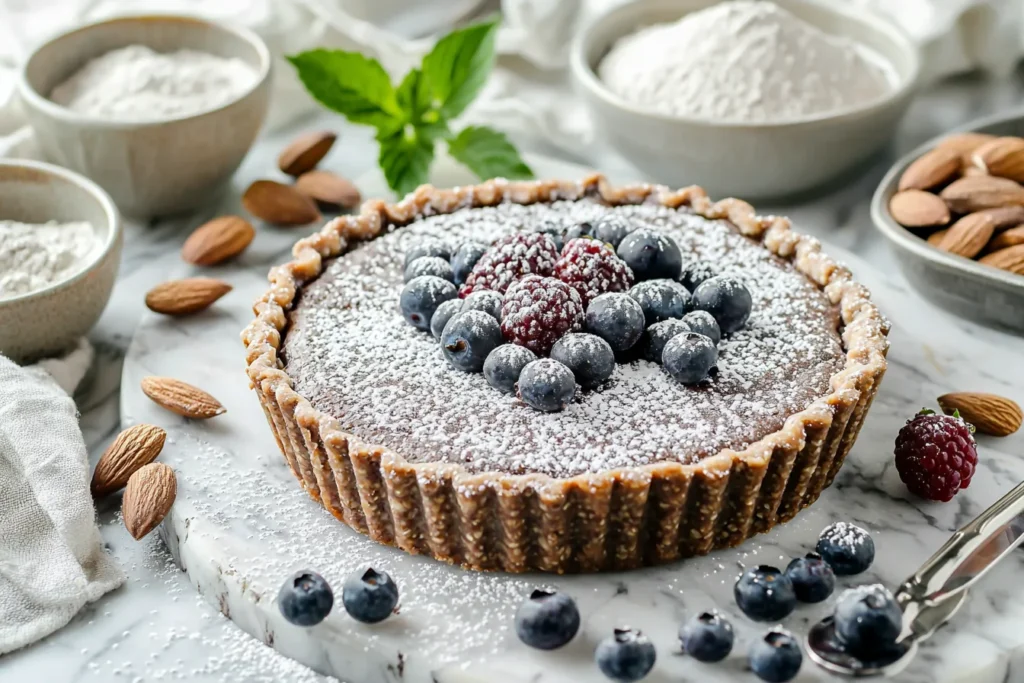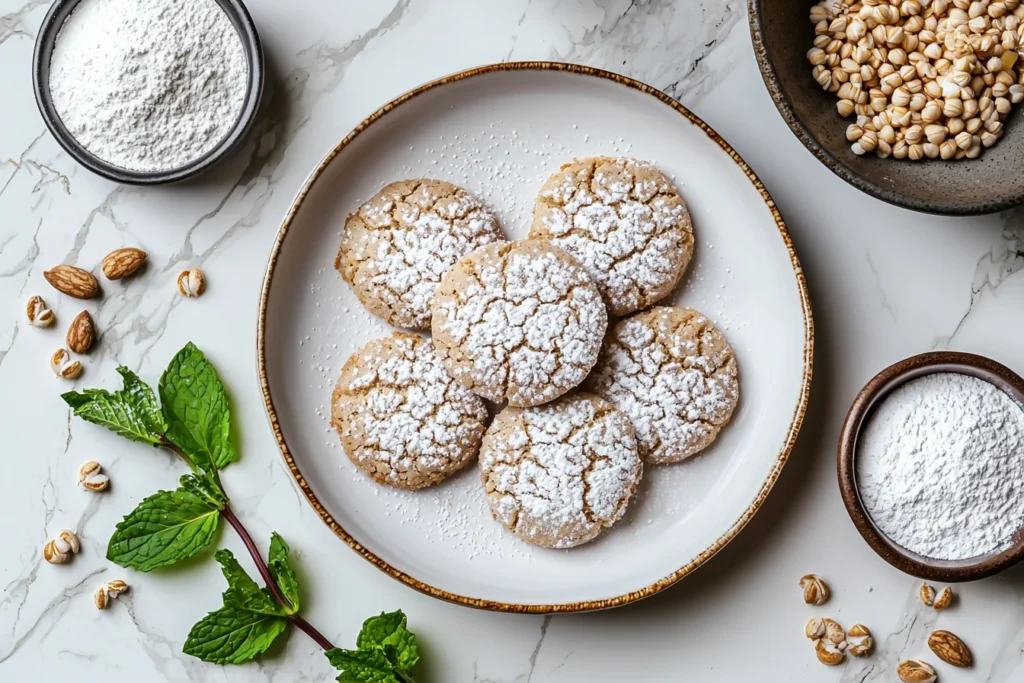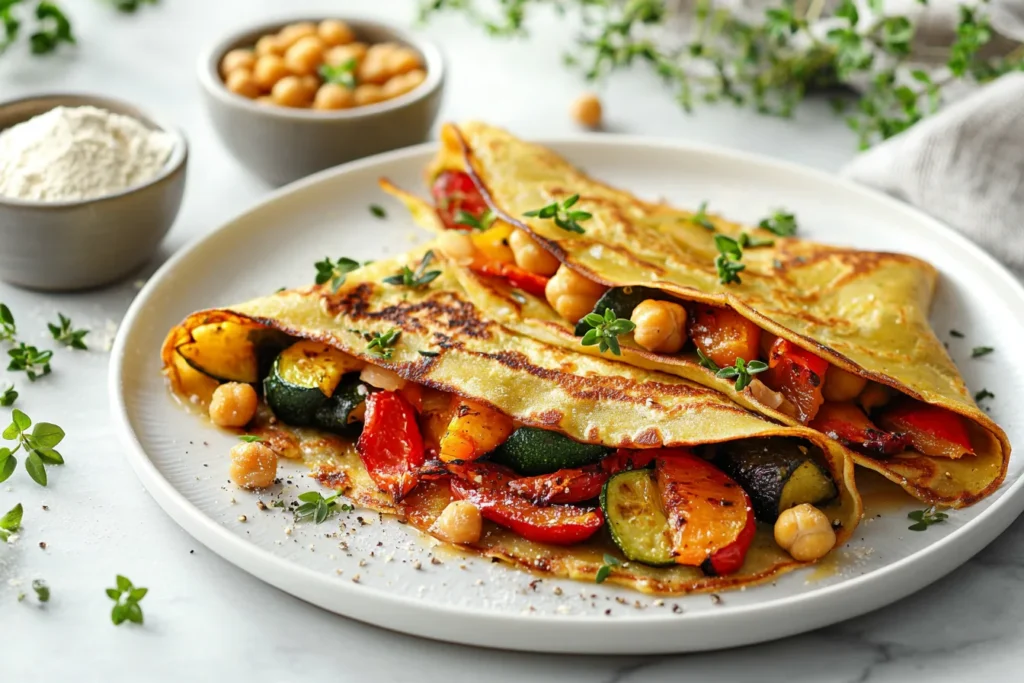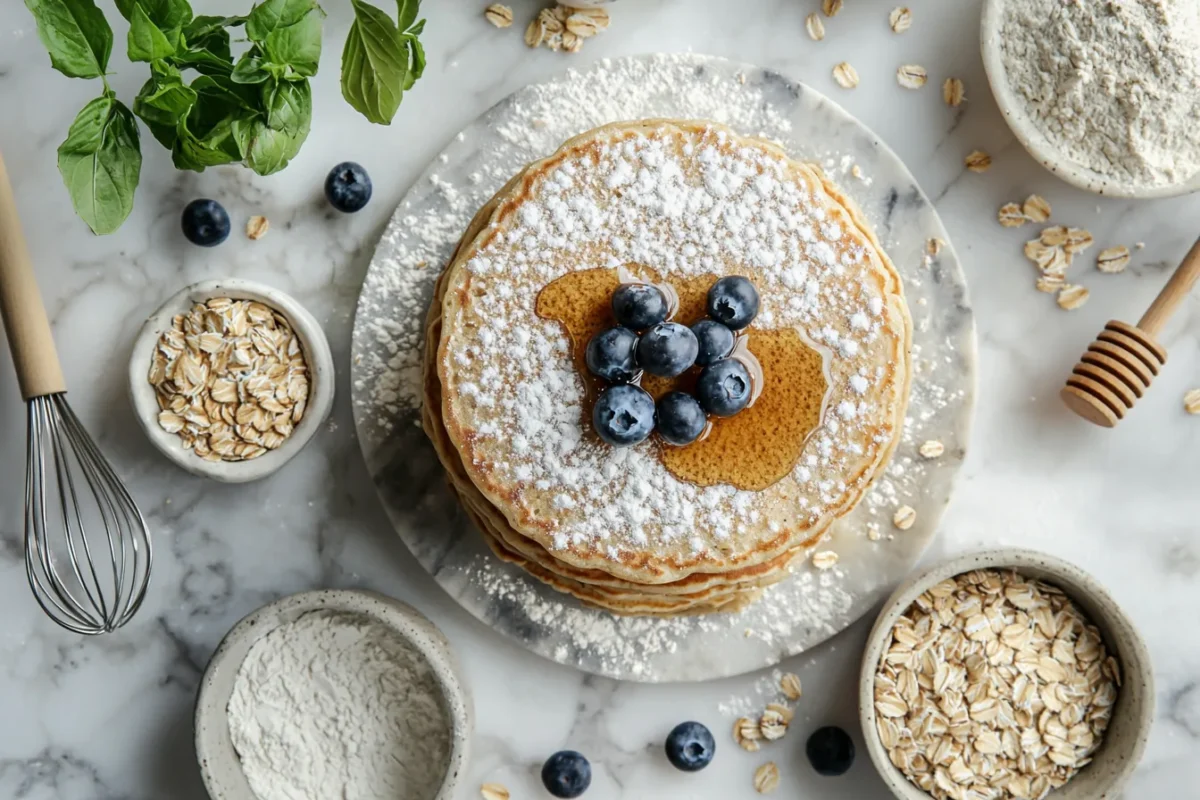Finding the right flour to mix with buckwheat flour can feel like solving a puzzle. First, buckwheat’s bold flavor and dense texture make it amazing, but tricky to balance. If you’ve been wondering what flour is best to mix with buckwheat flour, you’re in the right place! This guide will make it simple and fun to create the perfect combinations.
Next, mixing buckwheat with other flours can make recipes lighter, fluffier, and even more delicious. It’s great for sweet treats like pancakes and savory dishes like flatbreads. For savory inspiration, explore recipes for savory buckwheat cakes, which highlight the versatility of buckwheat in savory creations. Plus, it works beautifully for gluten-free and health-conscious baking.
You’ll love how versatile and easy these blends are to try at home. Ready to bake something amazing? Keep reading to discover the best flours to mix with buckwheat and how to use them for perfect results. Have a favorite flour to pair with buckwheat? Let us know in the comments below and inspire others!
Table of Contents
Benefits of Combining Buckwheat Flour with Other Flours
Enhancing Texture and Structure in Baking
Buckwheat flour alone can make baked goods dense, but mixing it with other flours transforms the texture. For instance, adding all-purpose flour lightens the batter, creating fluffier cakes and softer muffins. First, the gluten in wheat-based flours helps provide structure, making it easier for baked goods to hold their shape. Then, the combination works beautifully in bread, ensuring a tender crumb.

Also, using almond flour or oat flour adds a slight creaminess, which complements buckwheat’s earthy flavor. These blends also improve elasticity, especially in pancakes and flatbreads. For more ideas, check out can you use buckwheat flour for cakes to learn how to master this balance in baking. For detailed nutritional information about buckwheat flour, refer to nutritional information about buckwheat flour. Another tip is to sift the flours together to avoid clumps and achieve a uniform mixture.
Mixing buckwheat with other flours not only enhances texture but also makes recipes more versatile. Whether you are baking a sweet treat or a savory dish, this method delivers excellent results. Try experimenting today and enjoy the perfect balance! What’s your go-to flour for improving the texture of buckwheat-based recipes? Share your tips in the comments!
Achieving Balanced Flavors with Flour Combinations
Buckwheat flour’s bold taste can sometimes overpower recipes, but combining it with other flours helps balance flavors. For example, rice flour’s mild taste smooths out buckwheat’s earthiness, making baked goods more enjoyable. This pairing works well for cakes, cookies, and even delicate crepes.
Next, almond flour brings a sweet nuttiness, which complements buckwheat beautifully in desserts like tarts and muffins. Additionally, mixing spelt flour with buckwheat creates a hearty, rustic flavor, perfect for bread or crackers. Enhance your recipes with tips from savory buckwheat cakes recipes to balance flavors in both sweet and savory dishes. Adding cinnamon or vanilla enhances the mix for sweet recipes, while herbs like rosemary pair well for savory creations.

Flour combinations allow you to adjust recipes to suit your taste while keeping the texture just right. By experimenting with different options, you’ll discover blends that work best for your favorite dishes. Why not try it today and create your ideal flavor profile?
Best Gluten-Free Flour Pairings for Baking
Almond Flour for a Nutty and Light Combination
Almond flour is one of the best flours to mix with buckwheat flour, especially for gluten-free recipes. First, its naturally sweet and nutty flavor complements buckwheat’s earthiness, making it ideal for desserts. Then, almond flour adds lightness to baked goods, helping to balance buckwheat’s dense texture.
This combination works well for cookies, cakes, and even crusts for pies. For a complete guide, check out can you use buckwheat flour to see how this pairing works for cookies, muffins, and more. Additionally, almond flour brings moisture, which prevents baked goods from feeling dry. When mixed with buckwheat, the result is a tender and soft texture, perfect for gluten-free treats.
To achieve the best consistency, use a 50:50 ratio of almond and buckwheat flours. You can also adjust the amounts depending on the recipe’s needs. This pairing is versatile and easy to work with, making it a go-to option for beginners and experienced bakers alike. Try it today for delicious results!
Rice Flour for Smooth and Versatile Results
Rice flour is another excellent choice to mix with buckwheat flour, thanks to its smooth and neutral flavor. First, rice flour lightens the texture of baked goods, which helps balance buckwheat’s density. This pairing is particularly great for recipes like pancakes, crepes, or gluten-free bread.

Also, rice flour is incredibly versatile and easy to find, making it convenient for many recipes. When combined with buckwheat, it creates a softer batter that’s easier to handle. In addition, rice flour’s mild taste lets buckwheat’s bold flavor shine without overpowering it. Discover more gluten-free pairings in gluten-free dairy-free breakfast ideas for inspiration and find creative ways to enjoy this combination.
For best results, start with a 60:40 ratio of rice to buckwheat flour. Adjust the mix based on whether you want a lighter or more robust final product. This combination offers a great starting point for gluten-free baking, whether sweet or savory. Give it a try—you’ll love the balance it creates!
How to Mix Buckwheat Flour with Wheat-Based Flours
Using All-Purpose Flour for Classic Recipes
Buckwheat flour and all-purpose flour make an excellent pair for traditional baked goods. First, the gluten in all-purpose flour provides elasticity, making doughs and batters easier to work with. Then, buckwheat adds a bold, nutty flavor, which gives recipes a unique twist.
This combination works beautifully in pancakes, muffins, and cookies. A 50:50 mix is a good starting point, ensuring a light texture with buckwheat’s signature earthiness. If you prefer a stronger buckwheat flavor, increase its proportion slightly while keeping the structure stable.
To ensure a smooth blend, sift the flours together before mixing them into your recipe. This prevents clumping and evenly distributes both flours. Whether you’re making sweet treats or savory creations, this pairing strikes the perfect balance between texture and flavor. Try it for your next recipe and enjoy the delicious results!
Using Spelt Flour to Enhance Nutritional Value
Spelt flour is an excellent partner for buckwheat flour, offering a nutritional boost and a mild flavor. First, spelt’s natural sweetness balances buckwheat’s bold taste, making it ideal for bread and pastries. Then, it brings additional protein and fiber, creating healthier baked goods without sacrificing taste.
The combination is especially great for rustic recipes like artisan bread, waffles, or savory pies. A good ratio to start with is 60:40, favoring spelt for a softer texture. Mixing the two flours also improves dough elasticity, which is useful for recipes requiring shaping or rolling.
To enhance the flavor further, consider adding spices or herbs, depending on whether you’re making sweet or savory dishes. This blend is versatile and easy to customize for any recipe. Why not give it a try and elevate your baking with this wholesome mix?
Best Ratios for Mixing Buckwheat Flour in Your Recipes
Balancing Flours for Pancakes, Cakes, and Muffins
Finding the right ratio when mixing buckwheat flour with other flours is key to perfect pancakes, cakes, and muffins. First, start with a 50:50 blend of buckwheat and another flour, such as all-purpose or almond. This ensures a balance between buckwheat’s density and the lightness of other flours.
For fluffier pancakes, slightly reduce the buckwheat to 40% and increase the complementary flour. This keeps the batter airy and easy to pour. Cakes and muffins also benefit from this ratio, offering a tender crumb with buckwheat’s nutty flavor shining through.
Always sift the flours together to avoid clumps and achieve an even mix. If you’re feeling creative, try adjusting the proportions to highlight different textures or flavors. With the right blend, your baked goods will turn out soft, delicious, and perfectly balanced every time. You’ve got this—start experimenting today!
Adjusting Ratios for Gluten-Free and Vegan Options
Creating gluten-free and vegan recipes with buckwheat flour requires thoughtful ratio adjustments. For a gluten-free mix, pair buckwheat with rice or oat flour in a 60:40 ratio. This combination balances the texture while keeping the recipe light, flavorful, and easy to work with.
Vegan recipes may need a bit more liquid due to buckwheat’s absorbent nature. Add extra plant-based milk, applesauce, or water to keep the batter smooth and prevent dryness. You can also use flaxseed or chia seed gels as binding agents to effectively replace eggs in your recipes.
Experimenting with these ratios allows you to tailor recipes to suit dietary needs without compromising taste, fluffiness, or texture. Whether you’re baking gluten-free bread or vegan pancakes, this method works beautifully and reliably. Try it today and enjoy delicious, allergy-friendly results that everyone in your family will love!
Tips for Perfectly Blending Buckwheat Flour with Other Flours
Sifting and Mixing Techniques for Better Results
When blending buckwheat flour with other flours, sifting and mixing are crucial for a smooth batter. First, always sift the flours together before adding them to your recipe. This step removes clumps, evenly distributes the two flours, and creates a consistent texture.
Next, mix the dry and wet ingredients gradually. Start by combining the flours with a whisk or sifter to aerate the mixture. Then, slowly incorporate the liquids, stirring just until combined. Overmixing can make the batter dense, so aim for a light and airy consistency.
These techniques work for any recipe, from pancakes to cakes. They ensure a seamless blend of buckwheat flour with other options like almond or rice flour. By following these simple steps, you’ll achieve better textures and flavors in your baked goods. Give it a try—your results will be worth the effort!
Adding Liquid Ingredients to Maintain Moisture
Buckwheat flour tends to absorb more liquid, so adjusting your recipe’s wet ingredients is essential. First, increase the amount of milk, water, or plant-based alternatives slightly to keep the batter moist. This ensures your baked goods don’t turn out dry, crumbly, or overly dense.
Next, consider adding moisture-rich ingredients like yogurt, applesauce, or mashed bananas. These not only improve the texture but also enhance the flavor beautifully. For example, bananas pair wonderfully with buckwheat’s nutty taste in muffins, pancakes, or quick breads.
Always monitor the batter’s consistency as you mix. It should feel slightly thicker than traditional recipes but still easy to pour, spread, or shape. With the right adjustments, you can maintain moisture and achieve soft, delicious results every time. Try these tips today and enjoy perfectly balanced textures in all your favorite creations!
Creative Recipes Using Buckwheat Flour Mixtures
Sweet Treats Made with Buckwheat and Oat Flour
Buckwheat and oat flour make an irresistible combination for sweet treats. First, oat flour adds a mild, natural sweetness that complements buckwheat’s bold and nutty flavor. Together, they create a balance perfect for cookies, muffins, cakes, and even pancakes.
This pairing also works beautifully for gluten-free recipes, offering a tender texture without any compromise. For a delicious dessert, try a buckwheat-oat chocolate chip cookie. The oat flour softens the dough, while buckwheat gives it a slightly earthy edge.
Always mix the flours evenly to ensure a smooth, consistent batter. Add wet ingredients like yogurt, applesauce, or honey for extra moisture and sweetness. These flours are easy to work with and versatile for a variety of creative recipes. Get creative with this combination and surprise your family with tasty, wholesome treats everyone will enjoy!
Savory Ideas Featuring Buckwheat and Chickpea Flour
For savory recipes, mixing buckwheat flour with chickpea flour creates a hearty, flavorful base. Chickpea flour’s nutty and slightly tangy taste enhances buckwheat’s boldness, making this pairing ideal for flatbreads, crepes, savory pancakes, and even breadsticks.
Start by blending equal parts of both flours, then add herbs or spices to suit your dish. This mix works well for gluten-free wraps, veggie-packed fritters, or even savory waffles.

Adding olive oil or tahini to the batter enhances the texture and gives a rich flavor to the final dish.
This combination is also protein-packed, making it perfect for those seeking healthier meal options. Whether you’re hosting brunch or preparing a light dinner, buckwheat and chickpea flour deliver satisfying results. Try this mix today and enjoy delicious savory creations with a wholesome twist that everyone will love!
Frequently Asked Questions (FAQs)
What goes well with buckwheat flour?
Buckwheat flour pairs beautifully with various flours and ingredients. Oat flour is a top choice for its mild sweetness and soft texture, making it perfect for baked treats like cookies or pancakes. Chickpea flour also works well, especially for savory dishes, as it adds protein and a slightly nutty flavor.
For flavor combinations, try mixing buckwheat with honey, cinnamon, or vanilla in sweet recipes. In savory options, pair it with garlic, herbs, or olive oil. These additions enhance the earthy notes of buckwheat flour while creating balanced and delicious results. You’re going to love experimenting with these ideas!
What flavors go well with buckwheat?
Buckwheat flour’s earthy, nutty flavor pairs perfectly with a variety of ingredients. In sweet recipes, it goes beautifully with honey, maple syrup, or vanilla. Adding warm spices like cinnamon, nutmeg, or ginger can bring out its rich depth. Fruits such as apples, pears, or berries also complement its bold taste.
For savory dishes, garlic, thyme, and rosemary pair wonderfully with buckwheat’s hearty profile. Cheese, like feta or goat cheese, adds a creamy contrast, while olive oil enhances its rustic flavor. These combinations create balanced and irresistible dishes. Try blending these flavors today, and enjoy a new twist in your cooking!
What is the ratio of buckwheat flour to regular flour?
The ratio of buckwheat flour to regular flour depends on the recipe and texture you want. A common starting point is a 1:1 ratio, where you mix equal parts of both flours. This balance provides structure from the regular flour while keeping the nutty flavor of buckwheat.
For lighter cakes or muffins, use more regular flour, such as a 2:1 ratio. For denser breads or pancakes, you can increase the buckwheat to match or exceed the regular flour. Adjust liquids slightly, as buckwheat absorbs more. Experiment with ratios, and find what works best for you!
What is the ratio of almond flour to buckwheat flour?
The ideal ratio of almond flour to buckwheat flour depends on your desired outcome. A common starting point is a 1:1 ratio, balancing almond flour’s richness with buckwheat’s earthy flavor. This works well for cakes, muffins, and cookies.
For a lighter texture, increase almond flour to a 2:1 ratio. This adds moisture and creates a softer crumb. For recipes needing a firmer texture, like flatbreads, use more buckwheat flour, such as a 1:2 ratio. Remember, almond flour is less absorbent, so adjust liquids as needed. Try these ratios and enjoy experimenting!
Crafting Delicious Recipes with the Perfect Buckwheat Flour Mix
Mixing buckwheat flour with other flours opens up endless possibilities for delicious recipes. First, combining it with complementary flours like oat, almond, or chickpea creates the ideal balance of flavor and texture. Each pairing brings its unique qualities, making your baked goods soft, flavorful, and easy to work with.
Next, mixing flours lets you experiment with gluten-free or protein-packed options. For instance, using chickpea flour adds a hearty touch to savory dishes, while oat flour creates a soft texture in sweet treats. For savory dishes, try savory buckwheat cakes recipes, or explore can you use buckwheat flour for more tips and ideas. These combinations are not only versatile but also cater to various dietary needs.
Finally, finding the right mix for your recipes is a fun and rewarding process. Start experimenting today with different combinations and flavors. Your creativity in the kitchen will lead to wholesome, tasty results. Have questions or unique recipes to share? Drop a comment below—we’d love to hear from you!

